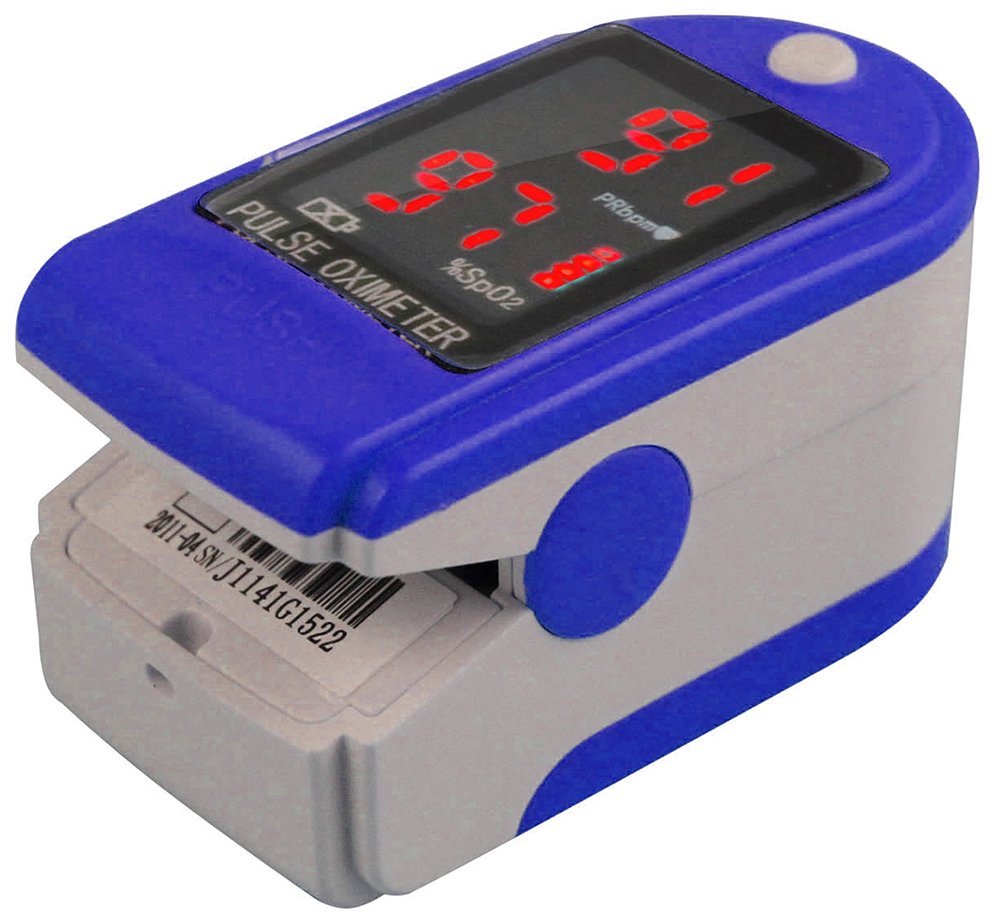|

If you are regularly flying your trips at 8,000' and above
(mine are 10-12,000'), there's no excuse not to be keeping an eye on your O2
Saturation level. Especially when these portable SpO2 meters are this CSOB
inexpensive. It wasn't too long ago that these units sold for over $200
 . Not anymore
folks, now you can know your O2 saturation anytime during your flight for a very
low price. . Not anymore
folks, now you can know your O2 saturation anytime during your flight for a very
low price.
Read this chilling account of hypoxic pilot
with ATC audio conversation HERE
Listen to the ATC audio of a Cirrus driver
becoming hypoxic at 17,000'
HERE
Getting to know your "normal" O2 saturation will help you to know what numbers
you may want to put O2 on or go lower before becoming "compromised" by hypoxia. At $30, the
Ascent unit is
one of the lowest priced portable fingertip pulse oximeter I've seen:
 I have one of these units and it
works great (except I paid $45 for it back in 2010)! Please feel free to send me a pirep on your unit
I have one of these units and it
works great (except I paid $45 for it back in 2010)! Please feel free to send me a pirep on your unit
 NEWS FLASH: These are now $30!
NEWS FLASH: These are now $30!
See how I installed a salvaged factory Oxygen system in my B55
HERE
Beech Lister and fellow Baron owner SS
provides the following pulse oximeter pirep:
I bought one of the cheapies and had no frame of reference. I
checked my numbers at various times and the device seemed to be working. At
Tullahoma, I had the chance to check it against the high priced Nonin of Larry
O. With his wife Carol as the test object, with my cheapie on one hand and the
Nonin on the other, we found no difference between the two units. The display of
the Nonin was an easier one to read, but mine was still okay. Questions such as
battery life and durability are still unresolved. My guess is that they are good
enough.
Here is another potential CSOB
Pulse Oximeter:


Available from Walgreens at about $38
Here is another unit @ ~$15 from Amazon:

Here is another unit @ $34 from
Costco:

Get yourself some hypoxia background info with this article written by Mike
Busch & Dr. Brent Blue:
HERE
| Altitude in
Flight level |
Time of Useful Consciousness |
Altitude in
meters |
Altitude in
feet |
| FL 150 |
30 min or more |
4,572 m |
15,000 |
| FL 180 |
20 to 30 min |
5,486 m |
18,000 |
| FL 220 |
10 Min |
6,706 m |
22,000 |
| FL 250 |
3 to 5 min |
7,620 m |
25,000 |
| FL 280 |
2.5 to 3 min |
8,534 m |
28,000 |
| FL 300 |
1 to 2 min |
9,144 m |
30,000 |
| FL 350 |
0.5 to 1 min |
10,668 m |
35,000 |
| FL 400 |
15 to 20 sec |
12,192 m |
40,000 |
| FL 430 |
9 to 12 sec |
13,106 m |
43,000 |
| FL 500 and above |
9 to 12 sec |
15,240 m |
50,000 |
So, no excuse to be hypoxic or even be slightly compromised and not know it. Any
serious aviator flying trips of over an hour at or above 8,000', IMHO, should
have one of these in their airplane to keep an eye on things!
Don't even think
about being a turbo driver up there on your factory O2 or portable O2 system
without one of these inexpensive ways to be SURE your system is keeping you in
good shape!
Read what happened to this turbo driver HERE
Hypoxia
Audio
Listen to this
FILE, (contributed by
Beech Lister & Lindy Winning Bonanza Owner Doug G.), these guys were VERY lucky
to live to tell the tale. Here is the back story:
The events unfolded on July 26, 2008 when controller McCombs accepted the
hand-off of KFS66 (call sign Kalitta 66), which appeared to have a stuck mike
creating incomprehensible transmissions. Unclear to those in the Center,
however, was that the co-pilot's arm was all the while moving violently and
uncontrollably on the other end as the captain worked hard to hand fly the
aircraft.
Through the help of another pilot's translation, Jay
learned that the aircraft had declared an emergency. The plane was quickly
changing altitude and McCombs immediately began to suggest closer airports, only
to receive a reply that they wanted to continue to Ypsilanti, MI.
Amid the chaos to translate the captain's words, fellow controller Stephanie
Bevins turns on the receiver so that she can now hear the pilot with her own
headset. As she thinks through the symptoms in her head, she concludes that he
must be hypoxic, a serious condition involving lack of oxygen due to
pressurization problems. She knows immediately that they must descend the
aircraft.
Following Bevin's initiative, McCombs begins bringing the
aircraft to the lowest altitude available in order to alleviate the possible
oxygen deprivation. Unable to answer questions, the pilot is only able to
respond to direct commands that the controllers now begin to voice. "Descend and
maintain," they repeat.
Remarkably, the captain's inability to turn on autopilot requires him to have to
work in order to fly the airplane, keeping him conscious and the plane airborne.
The pilot's words gradually become more understandable, and around 11,000 feet,
he returns to normal and confirms that he had, indeed, been suffering from
hypoxia.
Here is a report on cannulas done by CAMI.
The purpose of this study was to identify the
performance capabilities of pulse oxygen delivery systems that may be utilized
in the general aviation flight environment. This study was requested by the FAA
Northwest Mountain Region Aircraft Certification Region (ANM-100) to support
equipment certification efforts. Current FAA regulations for general aviation
oxygen equipment specify performance requirements for continuous flow oxygen
systems (oxygen supplied continuously to an oral-nasal mask or nasal cannula at
a specified flow rate), demand /diluter demand oxygen systems (100% oxygen or
appropriately diluted oxygen supplied only during inhalation), and pressure
demand oxygen systems (high altitude systems providing oxygen during inhalation
at pressures greater than ambient). Pulse oxygen systems provide a flow of
oxygen to a mask or nasal cannula only during the first phase of inhalation;
thus, the function of the pulse system contains elements of both continuous flow
and demand systems. Current regulations do not provide system performance or
design standards that adequately define pulse oxygen systems; thus, the sponsor
requested physiological evaluations at altitudes up to 25,000 ft.
Download it
HERE
Need a Portable Oxygen System or Accessories?

Check Out
DeltaOxygenSystems Pricing
Check Out CSOB Oxymizer Cannulas
 CSOB $20 Oxymizer cannula
HERE
CSOB $20 Oxymizer cannula
HERE
See how I installed a salvaged factory Oxygen system in my B55
HERE
|